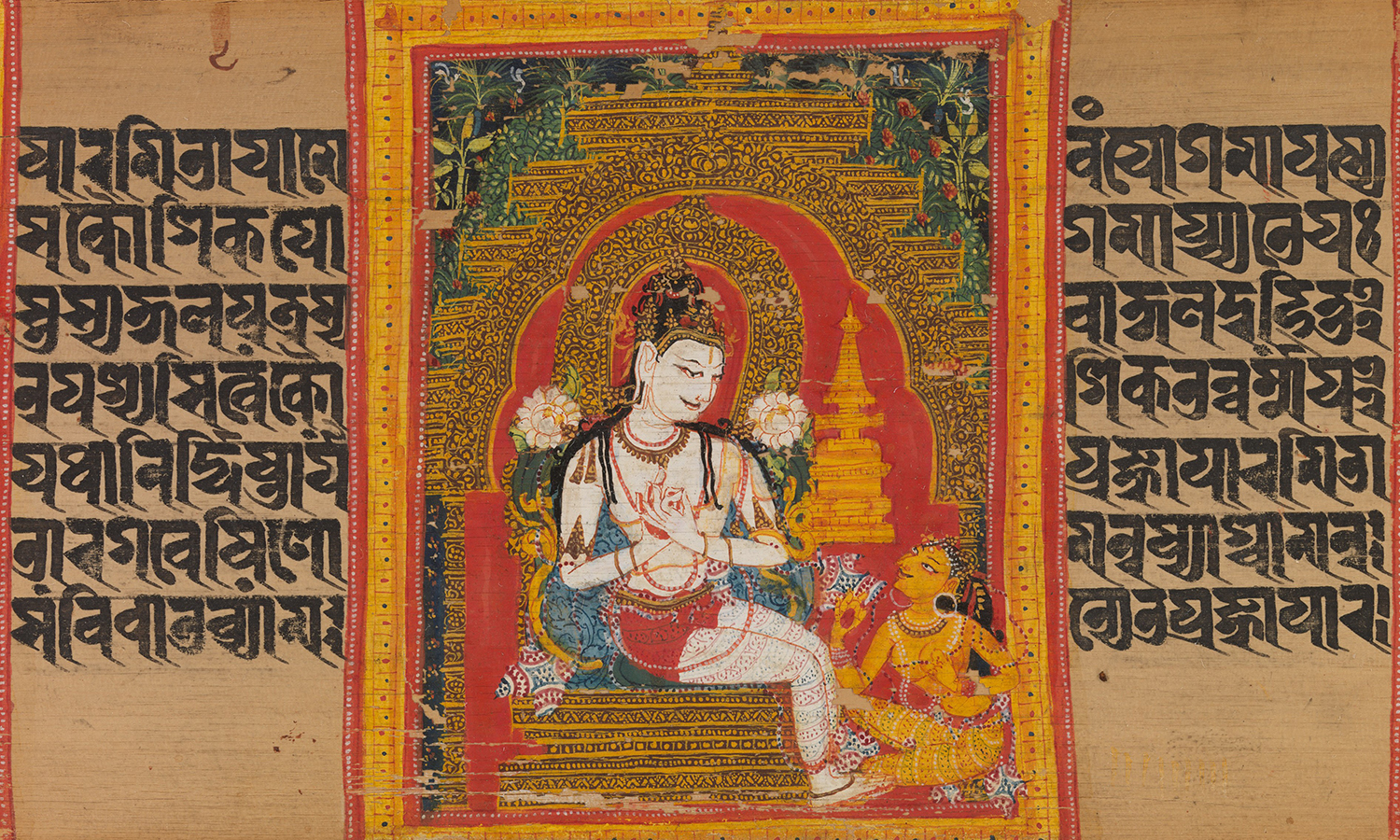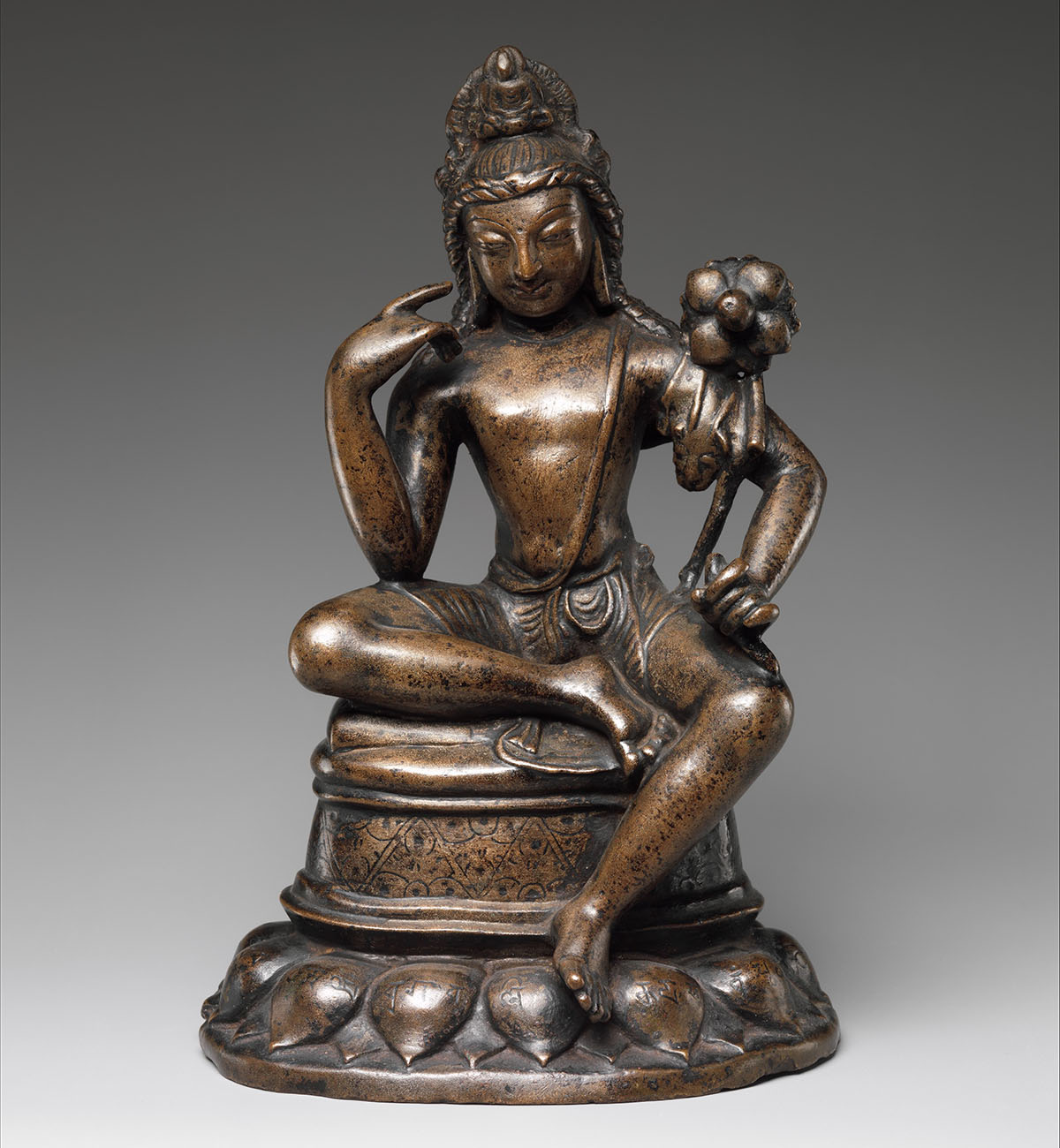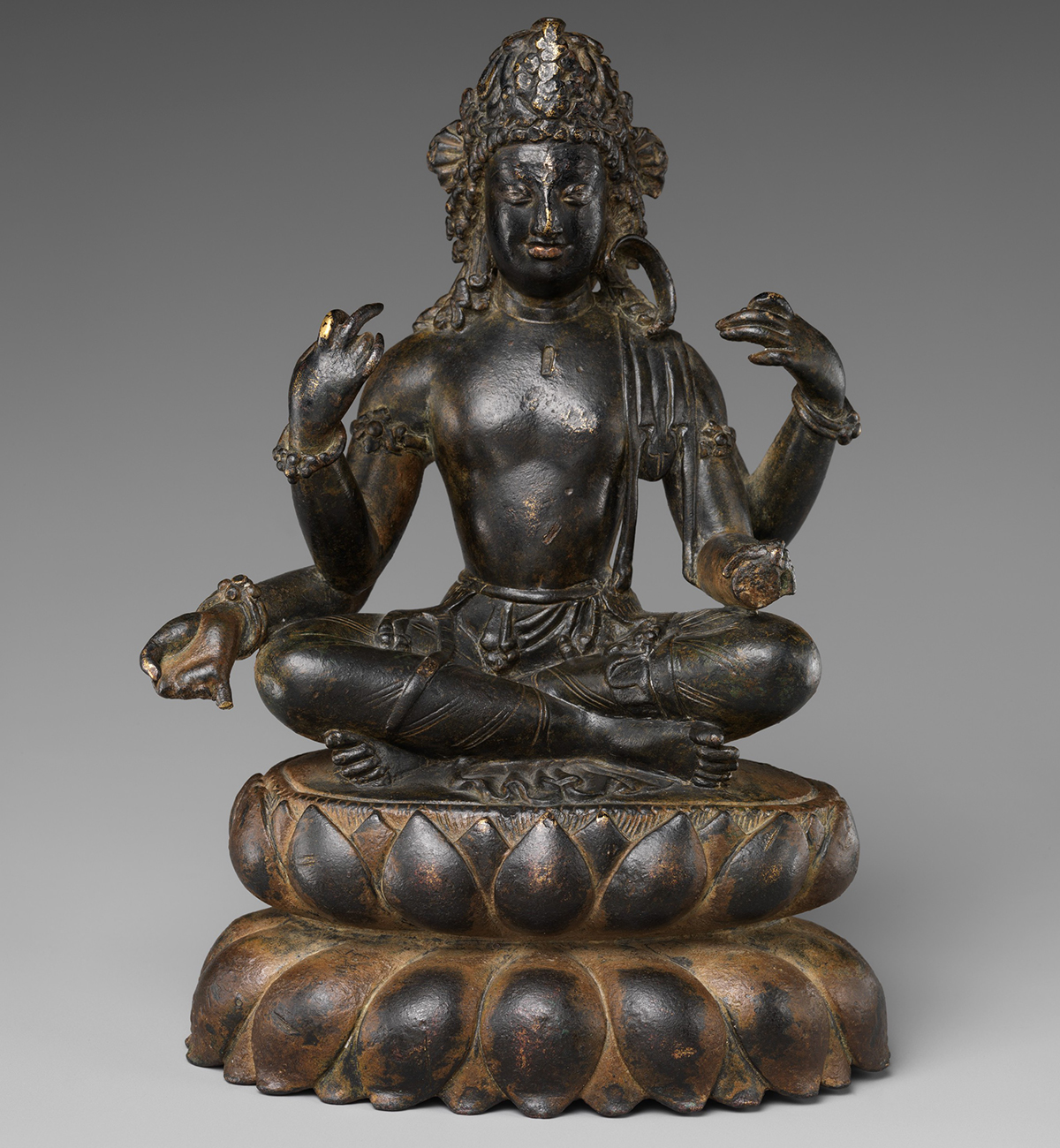ARTICLE
Avalokiteshvara
One of the most popular bodhisattvas in the Buddhist pantheon and frequently represented in Buddhist iconography, Avalokiteshvara – also known as Padmapani, meaning “lotus bearer” – is associated with compassion and the benevolent protection of the world. His name is derived from the Sanskrit words avalokita, meaning “to look on from above,” and ishvara, meaning “lord,” and has been interpreted as “the lord who looks in every direction” or “the lord of what we see.” In Mahayana Buddhism, Avalokiteshvara is considered the earthly manifestation of Amitabha, the celestial Buddha of light and perception and the primary figure in Pure Land Buddhism. He is also considered to be the ideal bodhisattva of Mahayana Buddhism, where bodhisattvas are believed to delay their nirvana to lead everyone to liberation from the cycle of life and death. Avalokiteshvara has been revered throughout the Buddhist world, across Central, South and East Asia since the first century CE.
The texts most pertinent to Avalokiteshvara are the Lotus and Karandavyuha sutras, and to a lesser extent, the Avatamsaka sutra. The Karandavyuha sutra lays out the mythological origin of Avalokiteshvara as a manifestation of the Buddha and provides devotees with the mantra om mani padme hum, meaning “I, the jewel in the lotus.” The phrase denotes the bodhisattva’s association with the lotus and is meant to be chanted during meditation while visualising him.
Owing to the geopolitical spread and reach of Buddhism, Avalokiteshvara is depicted in a variety of forms and incarnations. These also represent the diversity and scale of the Buddhist world, effectively conveyed by a monumental statue at an eleventh century monastery in Alchi, Ladakh, where the bodhisattva’s dhoti is painted with the images of other historical and mythical Buddhist shrines which are understood to be recognised only through this image. Scholars attribute the artistic and devotional tendency to present Avalokiteshvara in multiple forms to a combination of scriptures proclaiming his adaptable nature and regional variations on how ideas like compassion were visualised.
In Gandharan art, Avalokiteshvara, like other bodhisattvas, is depicted with a moustache and uttariya robes and is covered in jewellery. It is speculated that two key features of Avalokiteshvara – the lotus in his left hand and the statue of Amitabha in his hair – emerged during this period. Many of these earlier representations of the Buddha and bodhisattvas were subject to stylistic experimentation, owing to the absence of an established iconography, making it difficult to accurately identify bodhisattvas with interchangeable traits. For instance, the lotus was sometimes substituted for a wreath, and bodhisattvas such as Maitreya may also depict a Buddha on their head.
Buddhist art gained iconographic stability under Vakataka and Gupta rule – the second to sixth centuries in present-day north Pakistan, north India and the Deccan – due to a combination of imperial patronage and a textual foundation, primarily the key Mahayana sutras. By the fifth century, iconographically standardised bodhisattva images were being created at cultural centres such as Sarnath and Mathura, which acted as a basis for later images of the Buddha and bodhisattvas. It was during this period that the figure of Avalokiteshvara was given clear visual characteristics. He is shown displaying the varada mudra on his right hand and holding a lotus in his left. He is also depicted wearing elaborate jewels, counting a rosary and often features a statue of Amitabha in the jatamukha of his matted hair, which was considered the sign of an ascetic. The most recognisable depiction of Avalokiteshvara from this period is a painting in Cave 1 at Ajanta which dates to the fifth century CE, where the bodhisattva is shown in his protective aspect, heavily bejewelled and holding a white lotus, but without the Buddha statue in his elaborate headdress. His association with compassion and care are particularly visualised in his facial expression in this painting, a feature that is partly the consequence of style and partly a close reading of scripture.
Towards the end of the first millennium CE in the eastern and north-eastern parts of the Indian subcontinent, Avalokiteshvara and other bodhisattvas began to be depicted as many-limbed and many-headed figures under the emergent iconography of Vajrayana Buddhism, patronised primarily by the Pala Dynasty. This was largely the result of Tantric influences on Buddhist principles and ways of envisioning the world. Avalokiteshvara’s added arms allowed for a simultaneous representation of his many attributes, and made it possible to identify him in new forms and interpretations. A form of Avalokiteshvara worshipped in Nepal and Tibet, Ekadasamukha, has multiple arms and eleven faces arranged vertically in three tiers, meant to convey his all-seeing nature as well as his generosity and capacity to care for the world. Other uncharacteristic depictions of Avalokiteshvara, such as in the fierce and aggressive forms of Hayagriva and Mahakala, represent the driving away of self-destructive habits and other negative emotions from the minds of devotees.
These forms are canonical within Buddhist imagery and have basis in scripture. They also depict an intersection between the Tantric imagery of Buddhism and Hinduism. One of Avalokiteshvara’s forms, Neelakantha, is depicted with matted locks and a blue neck, much like the Hindu deity Shiva, with the main distinction being the image of Amitabha in Avalokiteshvara’s hair. Another form, Harihariharivahana, rides the shoulders of the Hindu god Vishnu, who in turn is seated on the anthropomorphic version of his mount Garuda, who is himself astride a lion. This unusual depiction, like others that feature Hindu gods, is extremely rare, with only one statue found in Nepal.
Avalokiteshvara’s forms, when seated, are typically depicted in lalitasana, a pose where one leg is folded in and the other is either dangling downwards or raised and bent with an arm resting over the knee in an attitude that is implicitly regal and relaxed. This seems to have derived from the practice of meditation in Vajrayana and related schools of Buddhism and the intersection between meditation and art as codified in the Sadhanamala, which included fifteen forms of Avalokiteshvara. This development combined the traits of Avalokiteshvara from the fourth and fifth centuries — introduced with Vakataka and Gupta patronage — to form descriptive as opposed to prescriptive representations, indicating that many such forms may pre-date the Sadhanamala. Textual and artistic evidence suggest that the most popular of these forms in India were the Sadaksari Lokeshvara, Simhanada, Khasarpana and, more rarely, Lokantha. Sadaksari Lokeshvara later became the central figure of Tibetan Buddhism, and is believed to be incarnated as the Dalai Lama.
Depending on the form, Avalokiteshvara may be flanked by companions, usually other bodhisattvas, most commonly Tara. In some instances, the companions assigned to one form of Avalokiteshvara may include his other forms, as is the case with Khasarpana, who is accompanied by Hayagriva among others. This suggests the complex, inter-related ideas of compassion conveyed by certain representations.
Beyond the Indian subcontinent and up till the present day, Avalokiteshvara is interpreted in a number of different ways in different countries. In China and other parts of east Asia, he is called Guanyin and has been depicted as female since the eleventh century. This form is possibly an interpretation of Avalokiteshvara’s fertility powers as described in the Lotus sutra, according to which she has the ability to grant children to devotees. In Japan, Guanyin has been worshipped as Kannon since the seventh century and takes seven different forms. In Tibet, each Dalai Lama is thought to be a reincarnation of Avalokiteshvara, or Chenrezig, as he is known locally.
Bibliography
Our website is currently undergoing maintenance and re-design, due to which we have had to take down some of our bibliographies. While these will be re-published shortly, you can request references for specific articles by writing to hellomapacademy@map-india.org.









